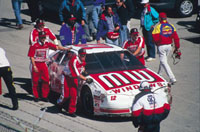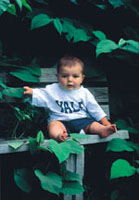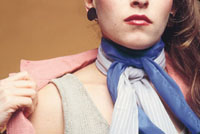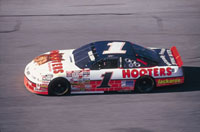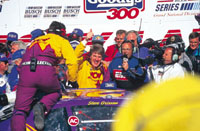When To Turn Off The Focus
Sometimes The Eye Is Quicker Than The Lens
One of the most important tips that I give aspiring photographers who own modern 35mm cameras is to learn to use their cameras totally manually. That's right, turn off the autoexposure and the autofocus, set the motor drive to single frame, and use your eyes and your brain instead. |
|||
When I first saw a press photographer using a Canon EOS-1 with a 28-70mm f/2.8 autofocus lens I was just blown away. I borrowed the camera for a minute and was dazzled by the focusing speed and accuracy. Here was a tool that I really needed, I thought; so I sold off a flight case full of Nikon F2s and F3s, Nikkor glass and related accessories and bought the EOS program lock stock and barrel. I must admit that the ergonomics of the EOS-1 and now the EOS-1N are truly wonderful, and I really have learned to love this system, but I have relied on the autofocus and autoexposure much less than I thought. |
|||
Once I had owned my EOS gear for a while and the newness of the system wore off, I took a good hard look at page after page of transparencies that I had shot and realized something very important: my work was no sharper on average than that shot with my manual focus Nikon stuff. In fact I found a few instances where the work was consistently out of focus, with a few in focus shots. Did the autofocus malfunction? Was this technology over-hyped? Of course not. The problem was that autofocus is dumb technology. Now, the engineers who invented it are probably quite brilliant, but the resulting product is just plain dumb. Aim it at the wall and it will focus at the wall, even if you want some tiny detail in the foreground in focus. Newer multizone focusing systems and Canon's great eye control focus are big improvements over the center-only focus schemes of old, but there are still hundreds of stuations where I feel that it is faster, easier and safer to focus manually. In complex situations, figuring out a way to tell the camera what to focus on may actually be more time consuming and more difficult than grabbing the focus ring and doing it yourself. |
|||
Oddly enough, I love autofocus in the studio. You would think that one of the places where you really wouldn't need autofocus is in a totally controlled environment, but I've found that when I shoot 35mm in the studio, whether for products or people, I like to move the camera around and constantly change perspectives. In the old days that meant continually rocking the focusing ring back and forth trying to maintain constant focus. Since those days I've discovered the EOS Custom Function 4 secret. (CF4 assigns the autofocus function a button on the rear of the camera or on the motor drive booster. The camera focuses only when you press the button rather than the shutter release.) I can't live without autofocus in the studio. As I move around I keep hitting the focus button on the camera until I get a focus right and also until it "looks" sharp to me, then I lay off the focus until I or my subject moves. This allows me to focus on something in the foreground by tipping down the camera, centering the object and automatically setting my focus. I then leave the focus locked on the foreground and re-frame the shot, and shoot knowing that the camera will not re-focus until I tell it to. The dumb technology now borrows a little smarts from me and we're working as a team. I find this preferable to the "press the shutter halfway" focus lock technique, which must be repeated before every shot or the camera simply re-focuses on the scene as it sees it, which may be on the wrong object. |
|||
A lot of parents have the same problem shooting their kids playing sports. Shoot a wide shot of the field at infinity and everything's fine. Rack your lens out to 200mm to catch your kid making a great play at second base and you're ready to shoot before the lens has motored its way into focus. I thought the speed and accuracy of autofocus would be a big help in such a situation, but I can focus from 6' to infinity in a fraction of the time that the camera can. Pros know all about this lag, both in camera reaction time and human reaction time, and keep a small armada of cameras ready and choose different camera/lens combinations to focus on different parts of the field. A wire service like Associated Press will send a small platoon of photographers to an NFL game, each person responsible for a different athlete or part of the field. You can't cover everything, so you increase your batting average by trying to anticipate action before it happens and have your camera and lens pointed in the right direction, focused and ready to go. This way if the play comes your way you've got the perfect shot. If it doesn't, wait until next time. |
